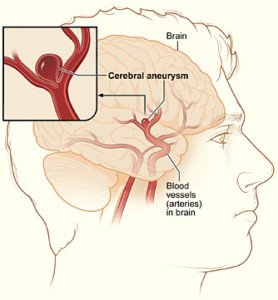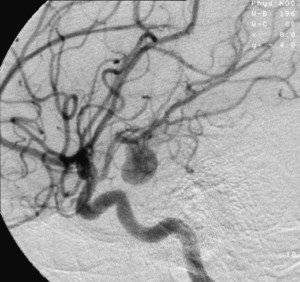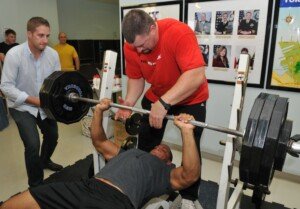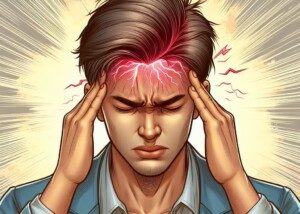
A sudden severe headache with that last bench press rep can have one of several possible causes.
You’ve been bench pressing for years without a hitch, but one day on the last repetition you’re struck by a sudden headache: severe, fast in onset, and it may or may not persist after your workout is finished.
Let’s look at what could be the cause of a sudden headache out of the blue as you grind out that last repetition in the bench press (or other big compound move) — and yet, this pain has never happened to you before.
Unfortunately, a quck-onset headache during or immediately after intense exercise isn’t always harmless or benign.
A headache may be induced by exercise, but this doesn’t mean there’s nothing seriously wrong.
“Exercise induced headaches are divided into two categories: primary and secondary,” says Lenny Cohen, MD, founder of Chicago Neurological Services; diplomate of the American Board of Psychiatry and Neurology.
“Primary headaches are usually brought up by exercises, while secondary exercise-induced headache can be due to any pathology directly affecting the brain — bleeding, tumor, etc.”
Secondary Type, Persists After Bench Pressing or Other Lifting
“With any sort of headache the patient’s concern is about possible aneurysm,” says Dr. Cohen.
“A typical presentation for aneurysm is ‘thunderclap headache,’ and such headaches never go away on their own and are commonly associated with secondary symptoms like photophobia [light sensitivity] or neck stiffness.”
Now keep in mind that you may have neck stiffness caused by bench pressing or another exercise.
Plus, some gyms have bright lights overhead that are clearly noticed when lying on a bench.
However, an aneursymal headache may also be accompanied (if not immediately, then very soon after onset) by double vision and/or a drooping eyelid — depending on the location of the aneurysm.
If you have a persisting, disabling headache after a workout, do not just think you could rest it off, even if you don’t have any other symptoms.
A physician should first rule out a brain bleed, which is an immediate medical emergency.
At the time of a headache, the patient will usually undergo a CT head scan, perhaps with a lumbar puncture.
The closer in time to the headache onset that you see a doctor, the more accurate the evaluation will be.
If there is an intracranial bleed, the cause would be the rupture of a pre-existing aneurysm.
Lifting weights does not cause an aneurysm to form.
But it can lead to rupture of one that’s already there — because heavy lifting spikes blood pressure.
The aneurysm could have been there for years, existing dormantly. This is a dilated, enlarged or bulging section of a blood vessel, as depiced below.

Its inner walls are thinned out and weakened (think of a balloon being blown up bigger and bigger; the rubber becomes thinner and weaker).

Image of an actual brain aneurysm; the bulge is obvious. Source: Lucien Monfils
When you bench press heavy weights and are straining to push out the last few reps, blood pressure is soaring — getting higher and higher as the set progresses towards the end.
This spike in blood pressure, in the event of an intracranial bleed, would have ruptured or torn the aneurysm.
Nevertheless, in people who work out and don’t smoke (smoking is a risk factor for aneurysms), it’s relatively uncommon for a headache to be caused by a brain bleed. You’re far more likely to die in a car accident on the way to the gym.
If a ruptured aneurysm is not quickly treated, it will be fatal or result in permanent brain damage.
Primary Type, May Go Away Soon After or Persist 48 Hours After Exercise
Now, what if you’ve been experiencing the bad headache during or right after bench pressing for many of your workouts, but each time, it goes away?
“This is a so-called exercise-induced headache,” says Dr. Cohen.
“Usually, symptoms are provoked by physical activity and go away when such activity is stopped.
“These headaches in the past were referred to as primary exertional headaches and usually brought up by exercises.
“These headaches are self-limiting but can last from a few minutes to 48 hours.

“The prevalence of PEH varies based on medical literature and ranging anywhere from 1% to 10%.
“It mostly affects young adults. Pathophysiology of PEH was attributed to dysregulated cerebro-vasculature.”
The precise mechanism, then, of PEH is not definitively known.
It’s believed, however, that when a person holds his breath during heavy exertion, this can lead to increased pressure in the thoracic cavity — leading to a reduction in drainage of the brain’s veins (as part of normal venous flow back to the heart).
This in turn ultimately leads to a temporary increase in oxygenated blood flow to the brain, increasing intracranial pressure: head pain.
If this sounds confusing, here’s the translation: It’s benign.
“The only time when one should worry is when this headache persists,” says Dr. Cohen.
“Pretreatment with NSAIDs 20-30 minutes prior to exercise would help with these headaches.
“Those who have a family history of cerebral aneurysm should get appropriate imaging like CTA or MRA if they develop PEH or any other time of headache.”
What may also help is to avoid bench pressing or other heavy lifting in a hot room.
Also make sure you’re hydrated throughout the workout, though a dehydration headache will not come on suddenly nor be severe.
The bench presser’s headache can last five minutes to 48 hours, according to the International Headache Society’s International Classification of Headache Disorders.
It can also be pulsating and is sudden in onset, but these features don’t mean it’s serious if the cause is primary exertion.
Gradual Onset Headache
In addition to dehydration, the cause may be strain in a shoulder muscle that can cause a spasm referring pain to the head, or irritation to a nerve that can radiate pain to the head.
If you have a sudden intense headache while bench pressing or other exercise, it’s also possible that the timing is a coincidence (if it’s a first-time event), and that the cause is unrelated to the exercise, such as a venous sinus thrombosis and meningitis.

 Merging traditional medicine with alternative therapy,
Merging traditional medicine with alternative therapy, 







































